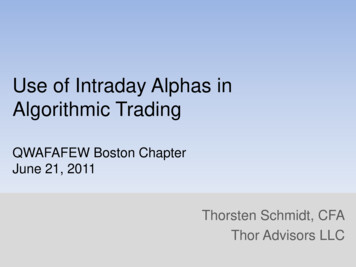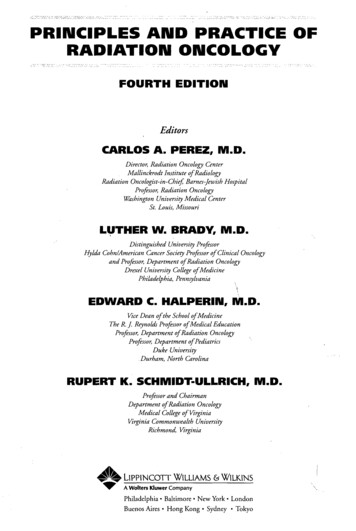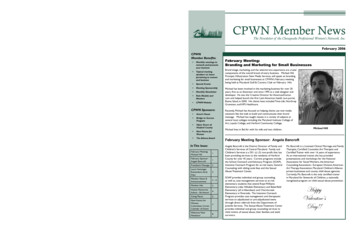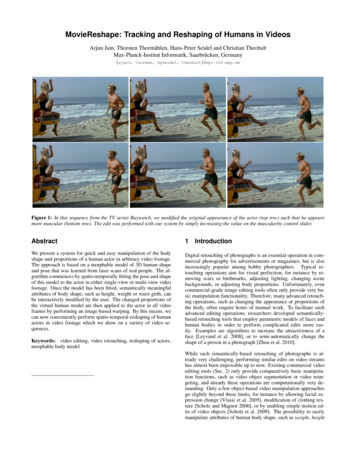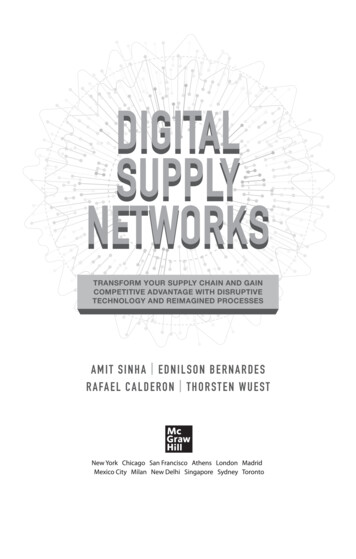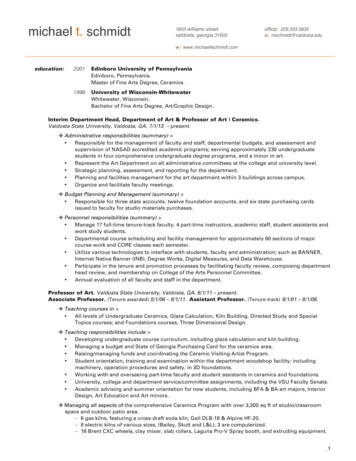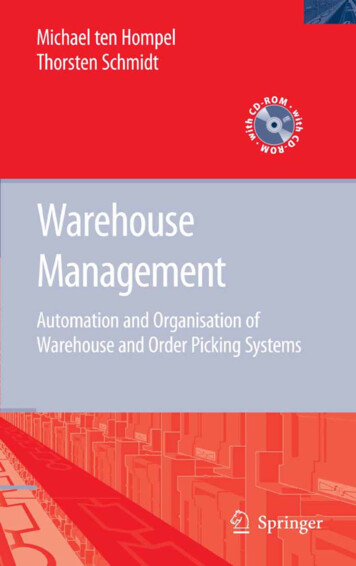
Transcription
Michael ten Hompel · Thorsten SchmidtWarehouse Management
Michael ten Hompel · Thorsten SchmidtWarehouseManagementAutomation and Organisation ofWarehouse and Order Picking SystemsWith 154 Figures and 48 Tables123
AuthorsProf. Dr. Michael ten HompelDr.-Ing. Thorsten SchmidtFraunhofer-Institut für Materialflußund Logistik (IML)Joseph-von-Fraunhofer-Str. 2–444227 Dortmund, dt@iml.fraunhofer.deLibrary of Congress Control Number: 2006930591ISBN-10 3-540-35218-X Springer Berlin Heidelberg New YorkISBN-13 978-3-540-35218-1 Springer Berlin Heidelberg New YorkThis work is subject to copyright. All rights are reserved, whether the whole or partof the material is concerned, specifically the rights of translation, reprinting, reuse ofillustrations, recitation, broadcasting, reproduction on microfilm or in any other way,and storage in data banks. Duplication of this publication or parts thereof is permittedonly under the provisions of the German Copyright Law of September 9, 1965, inits current version, and permission for use must always be obtained from Springer.Violations are liable for prosecution under the German Copyright Law.The publisher and the authors accept no legal responsibility for any damage causedby improper use of the instructions and programs contained in this book and the CDROM. Although the software has been tested with extreme care, errors in the softwarecannot be excluded.Springer is a part of Springer Science Business Mediaspringer.com Springer-Verlag Berlin Heidelberg 2007The use of general descriptive names, registered names, trademarks, etc. in this publication does not imply, even in the absence of a specific statement, that such namesare exempt from the relevant protective laws and regulations and therefore free forgeneral use.Typesetting: by the AuthorsProduction: LE-TEX Jelonek, Schmidt & Vöckler GbR, LeipzigCover: medionet AG, BerlinPrinted on acid-free paper68/3100YL - 5 4 3 2 1 0
ForewordModern warehouse and distribution systems constitute highly complex nodeswithin the value-added chain and have to meet a variety of requirements withregard to time, costs and quality. The efficient operation of such a system isa continuous and great challenge for anyone in charge. Recent developmentsof advanced computer and control technologies have provided the necessarycontrol and management systems (warehouse management systems, WMS).Nevertheless, due to the high complexity, users often find it hard to handlethese kinds of systems.Because of the large variety of solutions and system requirements thedesign, choice and operation of a WMS requires extensive know-how and experience. Many aspects have to be considered and implemented which dictatewhether the system will succeed or fail.The purpose of this book is to give the reader an overview over possiblesolutions and help him to make the right choice. It presents backgroundinformation, examines not only the potential, but also the risks and strategies,and thus sets the basis for comparisons for all those who are responsible forthe choice and specification of warehouse management systems. Furthermore,it is meant as basic support for students of logistic sciences and interestedbeginners who would like to become acquainted with the subject. This bookis related to practice without neglecting the basic context or implying specialtechnical knowledge. The basic processes and technologies that are requiredfor a better understanding are described in detail.In addition to this, the book will give system developers new ideas bypointing out the problems and limits of current developments and offeringnew approaches with regard to the structure and design of WMS.As an attachment, you will receive a simple, but functioning and welldocumented WMS, taken from the Open-Source Initiative myWMS. Thanksto the simulation environment, the software can be operated on a standardPC, independent of the platform and without the otherwise obligatory userlogin data. Thus, the operation, function and benefits of a WMS can bevisualized.This book could not have been written without the dedicated supportof an experienced team. We herewith want to express our gratitude to (inalphabetical order):
VIForewordHubert Büchter, for his basic consideration concerning the design of warehouse management systems,Ulrich Franzke, not only for his engagement, but also for his valuable contributions in the area of ident systems,Dirk Liekenbrock, the optimal expert with regard to control and optimization, andOliver Wolf, Mr. Warehouse-Logistics, for contributing to this book with hisexperience gathered during the Warehouse Logistics project.This book certainly would not have been possible without the constructiveand helpful cooperation of a multidisciplinary team of experts.Dortmund, August 2005Michael ten Hompel, Thorsten Schmidt
Contents1.Introduction . . . . . . . . . . . . . . . . . . . . . . . . . . . . . . . . . . . . . . . . . . . . . . 11.1 Requirements . . . . . . . . . . . . . . . . . . . . . . . . . . . . . . . . . . . . . . . . . . 21.1.1 Warehousing . . . . . . . . . . . . . . . . . . . . . . . . . . . . . . . . . . . . . 21.1.2 Characteristics of warehouse systems . . . . . . . . . . . . . . . . 41.1.3 Optimization of warehouse systems . . . . . . . . . . . . . . . . . 51.2 Warehouse Management . . . . . . . . . . . . . . . . . . . . . . . . . . . . . . . . . 61.3 System interfaces and definitions . . . . . . . . . . . . . . . . . . . . . . . . . 71.4 Structure and goal of this book . . . . . . . . . . . . . . . . . . . . . . . . . . . 112.Management of Warehouse Systems . . . . . . . . . . . . . . . . . . . . . .2.1 Logistic frameworks . . . . . . . . . . . . . . . . . . . . . . . . . . . . . . . . . . . . .2.1.1 Logistic principles . . . . . . . . . . . . . . . . . . . . . . . . . . . . . . . .2.1.2 Packaging and logistic units . . . . . . . . . . . . . . . . . . . . . . .2.2 Functions in warehouse systems . . . . . . . . . . . . . . . . . . . . . . . . . .2.2.1 Goods acceptance and receipt . . . . . . . . . . . . . . . . . . . . . .2.2.2 Storage . . . . . . . . . . . . . . . . . . . . . . . . . . . . . . . . . . . . . . . . .2.2.3 Retrieval / picking . . . . . . . . . . . . . . . . . . . . . . . . . . . . . . .2.2.4 Consolidation point . . . . . . . . . . . . . . . . . . . . . . . . . . . . . . .2.2.5 Order-picking . . . . . . . . . . . . . . . . . . . . . . . . . . . . . . . . . . . .2.2.6 Packaging department . . . . . . . . . . . . . . . . . . . . . . . . . . . .2.2.7 Shipping department . . . . . . . . . . . . . . . . . . . . . . . . . . . . . .2.3 Warehouse management system . . . . . . . . . . . . . . . . . . . . . . . . . .2.3.1 Warehouse management . . . . . . . . . . . . . . . . . . . . . . . . . . .2.3.2 Reorganization . . . . . . . . . . . . . . . . . . . . . . . . . . . . . . . . . . .2.3.3 Conveyor management and control systems . . . . . . . . . .2.3.4 Data collection, processing and visualization . . . . . . . . .2.3.5 Stocktaking . . . . . . . . . . . . . . . . . . . . . . . . . . . . . . . . . . . . . .2.4 Basic data and key performance indicators of warehouse systems2.4.1 Basic data . . . . . . . . . . . . . . . . . . . . . . . . . . . . . . . . . . . . . . .2.4.2 Logistic key performance indicators . . . . . . . . . . . . . . . . .2.5 Special procedures and methods . . . . . . . . . . . . . . . . . . . . . . . . . .2.5.1 Cross docking . . . . . . . . . . . . . . . . . . . . . . . . . . . . . . . . . . . .2.5.2 Outsourcing of the physical distribution and warehousing processes . . . . . . . . . . . . . . . . . . . . . . . . . . . . . . . . .131313162020252830304445464650505153565657595961
VIIIContents2.5.3 Application Service Providing . . . . . . . . . . . . . . . . . . . . . . 623.Fundamentals of an Operational Optimization . . . . . . . . . . . .3.1 Optimization in short . . . . . . . . . . . . . . . . . . . . . . . . . . . . . . . . . . .3.1.1 Background . . . . . . . . . . . . . . . . . . . . . . . . . . . . . . . . . . . . .3.1.2 Classification of the operational optimization . . . . . . . .3.1.3 Terms and elements of dispatching . . . . . . . . . . . . . . . . . .3.2 Optimization processes in a warehouse . . . . . . . . . . . . . . . . . . . .3.2.1 Transport optimization . . . . . . . . . . . . . . . . . . . . . . . . . . . .3.2.2 Sequencing of picking orders . . . . . . . . . . . . . . . . . . . . . . .3.2.3 Routing in the warehouse . . . . . . . . . . . . . . . . . . . . . . . . .3.2.4 Comprehensive order dispatching . . . . . . . . . . . . . . . . . . .3.3 Optimization of solutions . . . . . . . . . . . . . . . . . . . . . . . . . . . . . . . .3.3.1 General aspects . . . . . . . . . . . . . . . . . . . . . . . . . . . . . . . . . .3.3.2 Overview over the optimization procedures . . . . . . . . . .3.3.3 Examples of known methods . . . . . . . . . . . . . . . . . . . . . . .63636365676868767879818182844.Warehousing and Conveying Principles . . . . . . . . . . . . . . . . . . .4.1 Warehouse systems . . . . . . . . . . . . . . . . . . . . . . . . . . . . . . . . . . . . .4.1.1 Ground store . . . . . . . . . . . . . . . . . . . . . . . . . . . . . . . . . . . .4.1.2 Statical racking systems . . . . . . . . . . . . . . . . . . . . . . . . . . .4.1.3 Dynamical racking system . . . . . . . . . . . . . . . . . . . . . . . . .4.1.4 Pre-rack zone . . . . . . . . . . . . . . . . . . . . . . . . . . . . . . . . . . . .4.2 Transport systems . . . . . . . . . . . . . . . . . . . . . . . . . . . . . . . . . . . . . .4.2.1 Conveyors . . . . . . . . . . . . . . . . . . . . . . . . . . . . . . . . . . . . . . .4.2.2 Transporters . . . . . . . . . . . . . . . . . . . . . . . . . . . . . . . . . . . . .4.3 Sorting and distribution systems . . . . . . . . . . . . . . . . . . . . . . . . .4.3.1 Applications . . . . . . . . . . . . . . . . . . . . . . . . . . . . . . . . . . . . .4.3.2 The basic structure of sorting systems . . . . . . . . . . . . . .4.3.3 Distribution technology . . . . . . . . . . . . . . . . . . . . . . . . . . .4.3.4 Control and strategies . . . . . . . . . . . . . . . . . . . . . . . . . . . .4.4 Robots in warehouse systems . . . . . . . . . . . . . . . . . . . . . . . . . . . .4.4.1 Palletizing robots . . . . . . . . . . . . . . . . . . . . . . . . . . . . . . . . .4.4.2 Order-picking robots . . . . . . . . . . . . . . . . . . . . . . . . . . . . . Automation of the Material Flow . . . . . . . . . . . . . . . . . . . . . . . . .5.1 Basics of automation . . . . . . . . . . . . . . . . . . . . . . . . . . . . . . . . . . . .5.1.1 History of the material flow automation . . . . . . . . . . . . .5.1.2 Terms and definitions . . . . . . . . . . . . . . . . . . . . . . . . . . . . .5.1.3 The structure of control systems . . . . . . . . . . . . . . . . . . .5.2 Control engineering . . . . . . . . . . . . . . . . . . . . . . . . . . . . . . . . . . . . .5.2.1 Classification of controls . . . . . . . . . . . . . . . . . . . . . . . . . . .5.2.2 Programmable logic controllers . . . . . . . . . . . . . . . . . . . . .5.2.3 Computer control . . . . . . . . . . . . . . . . . . . . . . . . . . . . . . . .5.3 Sensors . . . . . . . . . . . . . . . . . . . . . . . . . . . . . . . . . . . . . . . . . . . . . . . .137137138139140144144147152153
Contents5.3.1 Sensor classifications . . . . . . . . . . . . . . . . . . . . . . . . . . . . . .5.3.2 Mechanically operated sensors . . . . . . . . . . . . . . . . . . . . .5.3.3 Optical sensors . . . . . . . . . . . . . . . . . . . . . . . . . . . . . . . . . . .5.3.4 Magnetic and inductive sensors . . . . . . . . . . . . . . . . . . . .5.3.5 Ultrasonic sensors . . . . . . . . . . . . . . . . . . . . . . . . . . . . . . . .5.4 Actuators . . . . . . . . . . . . . . . . . . . . . . . . . . . . . . . . . . . . . . . . . . . . .5.4.1 The tasks and structures of actuator systems . . . . . . . .5.4.2 Electrical drives . . . . . . . . . . . . . . . . . . . . . . . . . . . . . . . . . .5.4.3 Fluid drives . . . . . . . . . . . . . . . . . . . . . . . . . . . . . . . . . . . . .5.5 Interfaces in automation systems . . . . . . . . . . . . . . . . . . . . . . . . .5.5.1 Analogous and binary data transmission . . . . . . . . . . . . .5.5.2 Digital data transmission . . . . . . . . . . . . . . . . . . . . . . . . . .5.5.3 Field bus systems . . . . . . . . . . . . . . . . . . . . . . . . . . . . . . . tic Identification . . . . . . . . . . . . . . . . . . . . . . . . . . . . . . . . . . 1796.1 Codes and characters . . . . . . . . . . . . . . . . . . . . . . . . . . . . . . . . . . . 1796.1.1 Encoding . . . . . . . . . . . . . . . . . . . . . . . . . . . . . . . . . . . . . . . . 1806.1.2 Encoding examples . . . . . . . . . . . . . . . . . . . . . . . . . . . . . . . 1806.2 1D–Codes . . . . . . . . . . . . . . . . . . . . . . . . . . . . . . . . . . . . . . . . . . . . . 1816.2.1 Code 2/5 . . . . . . . . . . . . . . . . . . . . . . . . . . . . . . . . . . . . . . . . 1826.2.2 Check digit calculation Code 2/5 . . . . . . . . . . . . . . . . . . . 1856.2.3 Code 2/5 interleaved . . . . . . . . . . . . . . . . . . . . . . . . . . . . . . 1866.2.4 Code 128 . . . . . . . . . . . . . . . . . . . . . . . . . . . . . . . . . . . . . . . . 1886.2.5 Check digit calculation code 128 . . . . . . . . . . . . . . . . . . . . 1916.2.6 The character sets of the code 128 . . . . . . . . . . . . . . . . . . 1926.2.7 Mixed character sets in code 128 and their optimization1946.2.8 Code sizes, tolerances and reading distances . . . . . . . . . 1956.3 Printing method and quality . . . . . . . . . . . . . . . . . . . . . . . . . . . . . 1976.3.1 Labelling techniques . . . . . . . . . . . . . . . . . . . . . . . . . . . . . . 1976.3.2 Quality requirements . . . . . . . . . . . . . . . . . . . . . . . . . . . . . 1986.3.3 Selection of the printing technique . . . . . . . . . . . . . . . . . . 1986.4 Semantics in the code: EAN 128 . . . . . . . . . . . . . . . . . . . . . . . . . . 2006.4.1 Global location numbering (GLN) . . . . . . . . . . . . . . . . . . 2016.4.2 International article number (EAN) . . . . . . . . . . . . . . . . . 2036.4.3 Serial shipping container code (SSCC) . . . . . . . . . . . . . . 2036.4.4 Characteristics of the code EAN 128 . . . . . . . . . . . . . . . . 2046.5 Scanner technology, devices, interfaces . . . . . . . . . . . . . . . . . . . . 2086.5.1 Barcode scanner . . . . . . . . . . . . . . . . . . . . . . . . . . . . . . . . . . 2086.5.2 Handheld scanners . . . . . . . . . . . . . . . . . . . . . . . . . . . . . . . 2086.5.3 Stationary scanners . . . . . . . . . . . . . . . . . . . . . . . . . . . . . . . 2096.6 2D-Codes . . . . . . . . . . . . . . . . . . . . . . . . . . . . . . . . . . . . . . . . . . . . . . 2106.6.1 Stacked barcodes . . . . . . . . . . . . . . . . . . . . . . . . . . . . . . . . . 2116.6.2 Matrix codes . . . . . . . . . . . . . . . . . . . . . . . . . . . . . . . . . . . . 2126.7 Radio frequency identification . . . . . . . . . . . . . . . . . . . . . . . . . . . . 214
XContents6.7.1 Functioning and technical structure . . . . . . . . . . . . . . . . . 2146.7.2 Fields of application . . . . . . . . . . . . . . . . . . . . . . . . . . . . . . 2196.7.3 Comparison with barcode systems . . . . . . . . . . . . . . . . . . 2207.Information and Communication Technology . . . . . . . . . . . . .7.1 Communication technology . . . . . . . . . . . . . . . . . . . . . . . . . . . . . .7.1.1 Layered architectures . . . . . . . . . . . . . . . . . . . . . . . . . . . . .7.1.2 Protocols . . . . . . . . . . . . . . . . . . . . . . . . . . . . . . . . . . . . . . . .7.1.3 Transmission media . . . . . . . . . . . . . . . . . . . . . . . . . . . . . . .7.1.4 Network types and internetworking . . . . . . . . . . . . . . . . .7.1.5 Network addresses . . . . . . . . . . . . . . . . . . . . . . . . . . . . . . . .7.1.6 Examples . . . . . . . . . . . . . . . . . . . . . . . . . . . . . . . . . . . . . . .7.2 Data management . . . . . . . . . . . . . . . . . . . . . . . . . . . . . . . . . . . . . .7.2.1 Principles . . . . . . . . . . . . . . . . . . . . . . . . . . . . . . . . . . . . . . .7.2.2 File systems . . . . . . . . . . . . . . . . . . . . . . . . . . . . . . . . . . . . .7.2.3 Databases . . . . . . . . . . . . . . . . . . . . . . . . . . . . . . . . . . . . . . .7.2.4 Availability of data . . . . . . . . . . . . . . . . . . . . . . . . . . . . . . .7.3 User interface . . . . . . . . . . . . . . . . . . . . . . . . . . . . . . . . . . . . . . . . . .7.3.1 Terminals . . . . . . . . . . . . . . . . . . . . . . . . . . . . . . . . . . . . . . .7.3.2 Functional point of view . . . . . . . . . . . . . . . . . . . . . . . . . . .7.3.3 Access control . . . . . . . . . . . . . . . . . . . . . . . . . . . . . . . . . . .7.3.4 Internationalization . . . . . . . . . . . . . . . . . . . . . . . . . . . . . . .7.3.5 Help systems and help functions . . . . . . . . . . . . . . . . . . . .7.4 Operating systems . . . . . . . . . . . . . . . . . . . . . . . . . . . . . . . . . . . . . .7.4.1 Tasks . . . . . . . . . . . . . . . . . . . . . . . . . . . . . . . . . . . . . . . . . . .7.4.2 Principles . . . . . . . . . . . . . . . . . . . . . . . . . . . . . . . . . . . . . . .7.5 Programming languages . . . . . . . . . . . . . . . . . . . . . . . . . . . . . . . . .7.5.1 Compilers and interpreters . . . . . . . . . . . . . . . . . . . . . . . .7.5.2 Language concepts . . . . . . . . . . . . . . . . . . . . . . . . . . . . . . .7.5.3 Language generations . . . . . . . . . . . . . . . . . . . . . . . . . . . . .7.6 Basic principles of object-oriented programming . . . . . . . . . . . .7.6.1 Data abstraction . . . . . . . . . . . . . . . . . . . . . . . . . . . . . . . . .7.6.2 Classes and objects . . . . . . . . . . . . . . . . . . . . . . . . . . . . . . .7.6.3 Inheritance . . . . . . . . . . . . . . . . . . . . . . . . . . . . . . . . . . . . . .7.6.4 Unified modelling language . . . . . . . . . . . . . . . . . . . . . . . .7.7 Extensible markup language: XML . . . . . . . . . . . . . . . . . . . . . . .7.7.1 Key-value-coding . . . . . . . . . . . . . . . . . . . . . . . . . . . . . . . . .7.7.2 The syntax of XML . . . . . . . . . . . . . . . . . . . . . . . . . . . . . . .7.7.3 Parsers and processors . . . . . . . . . . . . . . . . . . . . . . . . . . . .7.7.4 Variety with style sheets . . . . . . . . . . . . . . . . . . . . . . . . . .7.8 Safety aspects . . . . . . . . . . . . . . . . . . . . . . . . . . . . . . . . . . . . . . . . . .7.8.1 Secrecy . . . . . . . . . . . . . . . . . . . . . . . . . . . . . . . . . . . . . . . . .7.8.2 Integrity assurance . . . . . . . . . . . . . . . . . . . . . . . . . . . . . . .7.8.3 Authentication . . . . . . . . . . . . . . . . . . . . . . . . . . . . . . . . . . 274275276277278280280
ContentsXI7.8.4 Authentication and electronic signature . . . . . . . . . . . . . 2818.Realization of Warehouse Management Systems . . . . . . . . . .8.1 Requirement definition . . . . . . . . . . . . . . . . . . . . . . . . . . . . . . . . . .8.1.1 As-is analysis . . . . . . . . . . . . . . . . . . . . . . . . . . . . . . . . . . . .8.1.2 Weak-point analysis . . . . . . . . . . . . . . . . . . . . . . . . . . . . . .8.1.3 Development of a target concept . . . . . . . . . . . . . . . . . . .8.2 Preparation of the tender documents . . . . . . . . . . . . . . . . . . . . . .8.2.1 Definition of the key performance indicators . . . . . . . . .8.2.2 Preparation of the technical specifications . . . . . . . . . . .8.2.3 Completion of the tender documents . . . . . . . . . . . . . . . .8.3 The placement of an order . . . . . . . . . . . . . . . . . . . . . . . . . . . . . . .8.3.1 Pre
Michael ten Hompel · Thorsten Schmidt Warehouse Management AutomationandOrganisation of Ware
